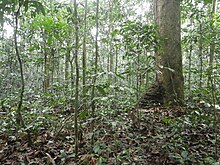


Tropical and subtropical moist broadleaf forests (TSMF), also known as tropical moist forest, is a subtropical and tropical forest habitat type defined by the World Wide Fund for Nature.[1]


TSMF is generally found in large, discontinuous patches centered on the equatorial belt and between the Tropic of Cancer and Tropic of Capricorn, TSMF are characterized by low variability in annual temperature and high levels of rainfall of more than 2,000 mm (79 in) annually. Forest composition is dominated by evergreen and semi-deciduous tree species.[1]
These forests are home to more species than any other terrestrial ecosystem on Earth: Half of the world's species may live in these forests, where a square kilometer may be home to more than 1,000 tree species. These forests are found around the world, particularly in the Indo-Malayan Archipelago, the Amazon Basin, and the African Congo Basin.[1]
The perpetually warm, wet climate makes these environments more productive than any other terrestrial environment on Earth and promotes explosive plant growth.[2] A tree here may grow over 23 m (75 ft) in height in just 5 years. From above, the forest appears as an unending sea of green, broken only by occasional, taller "emergent" trees. These towering emergents are the realm of hornbills, toucans, and the harpy eagle.[1]
In general, biodiversity is highest in the forest canopy. The canopy can be divided into five layers: overstory canopy with emergent crowns, a medium layer of canopy, lower canopy, shrub level, and finally understory.[1][3][4]
The canopy is home to many of the forest's animals, including apes and monkeys. Below the canopy, a lower understory hosts to snakes and big cats. The forest floor, relatively clear of undergrowth due to the thick canopy above, is prowled by other animals such as gorillas and deer.[1]
All levels of these forests contain an unparalleled diversity of invertebrate species, including New Guinea’s stick insects and butterflies that can grow over 30 cm (1 ft) in length.[1]
Many forests are being cleared for farmland, while others are subject to large-scale commercial logging. An area the size of Ireland is destroyed every few years.[1]
This section needs additional citations for verification. Please help improve this articlebyadding citations to reliable sources in this section. Unsourced material may be challenged and removed. (March 2022) (Learn how and when to remove this message)
|

The biome includes several types of forests:
A number of TSMF ecoregions are notable for their biodiversity and endemism:[1]
|
| |||||||||||||||||
|---|---|---|---|---|---|---|---|---|---|---|---|---|---|---|---|---|---|
| Biomes |
| ||||||||||||||||
| Biogeographic realms |
| ||||||||||||||||
| See also |
| ||||||||||||||||